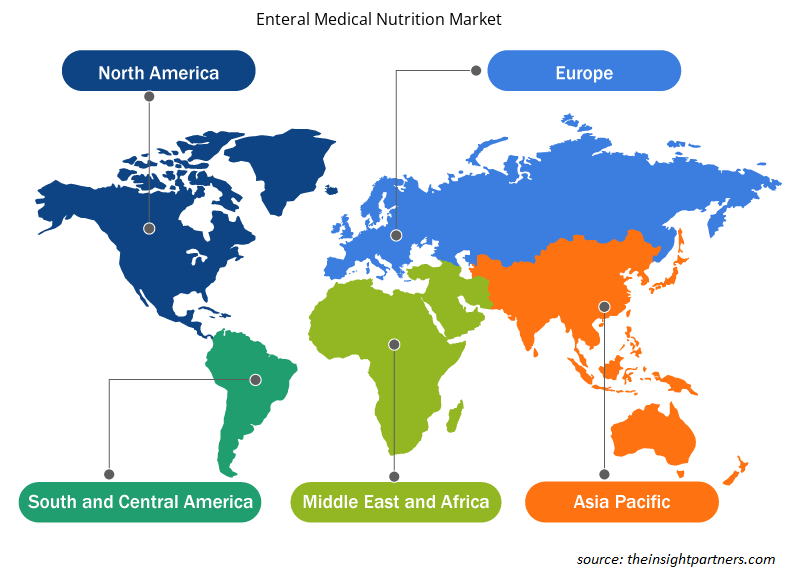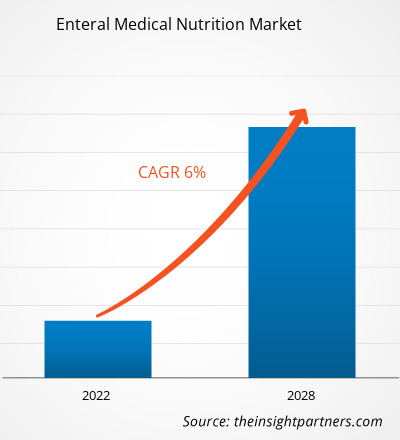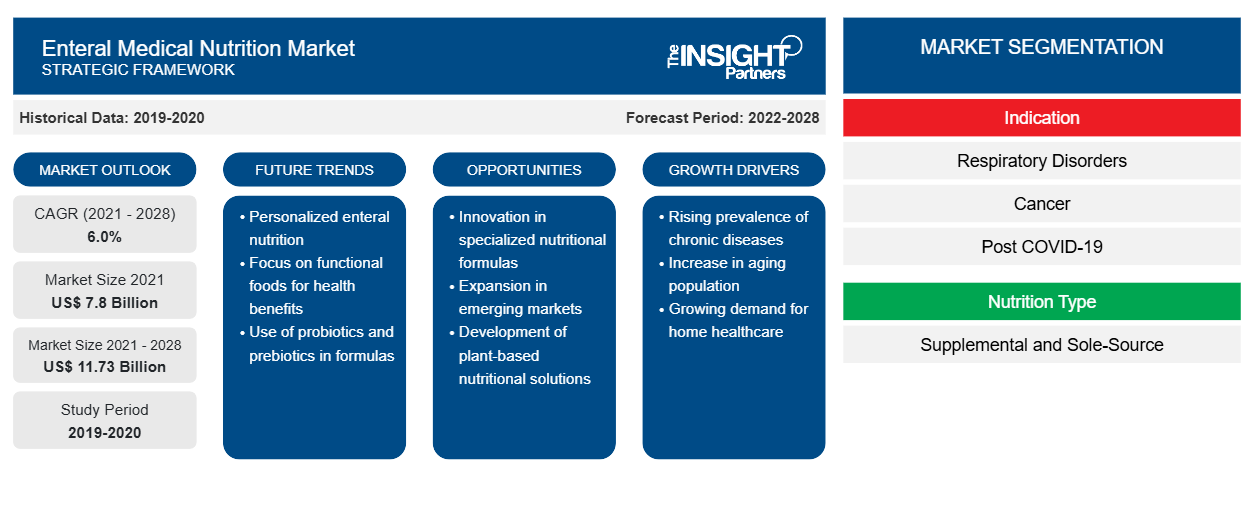Le marché de la nutrition médicale entérale devrait atteindre 11 726,37 millions USD d'ici 2028, contre 7 803,45 millions USD en 2021 ; il devrait croître à un TCAC de 6,0 % de 2022 à 2028.
La nutrition entérale (NE) est proposée aux patients dont les besoins énergétiques et nutritionnels ne peuvent être satisfaits par un apport alimentaire régulier. Les avantages de la nutrition entérale par rapport à la nutrition parentérale sont bien connus. Pour la plupart des patients pédiatriques dépendants de la nutrition entérale, une formule polymérique standard adaptée à l'âge et enrichie en fibres constitue un choix approprié.
Le marché de la nutrition médicale entérale est segmenté en fonction de l'indication, du type de nutrition, de la forme, du produit, du canal de distribution, de la tranche d'âge et de la géographie. Par géographie, le marché est largement segmenté en Amérique du Nord, Europe, Asie-Pacifique, Moyen-Orient et Afrique, et Amérique du Sud et centrale. Le rapport offre des informations et une analyse approfondie du marché, en mettant l'accent sur des paramètres tels que les tendances et la dynamique du marché, ainsi que sur l'analyse concurrentielle des principaux acteurs du marché mondial.
Personnalisez ce rapport en fonction de vos besoins
Vous bénéficierez d'une personnalisation gratuite de n'importe quel rapport, y compris de certaines parties de ce rapport, d'une analyse au niveau des pays, d'un pack de données Excel, ainsi que de superbes offres et réductions pour les start-ups et les universités.
-
Obtenez les principales tendances clés du marché de ce rapport.Cet échantillon GRATUIT comprendra une analyse de données, allant des tendances du marché aux estimations et prévisions.
Informations sur le marché
Augmentation de la prévalence de la cachexie
La cachexie est une maladie multifonctionnelle qui provoque une perte de poids extrême, une perte de muscle squelettique et de tissu adipeux, un déséquilibre de la régulation métabolique et une réduction de l'apport alimentaire. C'est une conséquence clinique grave de presque toutes les maladies chroniques lorsqu'elles atteignent un stade avancé. Selon le NCBI (National Center for Biotechnology Information), en 2016, la prévalence de la cachexie variait de 5 à 15 % chez les patients atteints d'insuffisance cardiaque chronique terminale. Elle survient fréquemment chez les patients souffrant d'insuffisance rénale chronique, de bronchopneumopathie chronique obstructive (BPCO) , de maladie neurologique et de polyarthrite rhumatoïde . Les taux de mortalité des patients atteints de cachexie varient de 15 à 25 % par an chez les patients atteints de BPCO sévère et de 20 à 40 % par an chez les patients atteints d'insuffisance cardiaque chronique ou de maladie rénale chronique.
Français La cachexie cancéreuse affecte négativement la qualité de vie des patients atteints de cancer et réduit l'efficacité de la chimiothérapie anticancéreuse et augmente sa toxicité, ce qui entraîne une augmentation de la mortalité liée au cancer et des dépenses en ressources médicales. Selon Globocan, l'Organisation mondiale de la santé a signalé 9,6 millions de décès et 18,1 millions de nouveaux cas de cancer en 2018. De plus, la cachexie cancéreuse est un syndrome de dépérissement qui survient chez jusqu'à 80 % des patients atteints de cancer. Selon l'article publié par le Département de médecine pulmonaire et de soins intensifs de Pékin, la prévalence de la cachexie est de 87 % chez les patients atteints de cancer du pancréas et de l'estomac ; de 61 % chez les patients atteints de cancer du côlon, du poumon et de la prostate ; et d'environ 40 % chez les patients atteints de cancer du sein, de sarcome, de leucémie et de lymphome de Hodgkin. De plus, 20 % du total des décès liés au cancer sont dus à la cachexie. Dans la cachexie, les nutriments dans l'organisme diminuent. Par conséquent, il est nécessaire d'apporter des nutriments externes pour poursuivre le traitement du cancer et de la BPCO. Les médecins privilégient la voie entérale pour fournir ces nutriments nécessaires au patient. Par conséquent, la prévalence croissante de la cachexie due à l'incidence croissante de diverses maladies chroniques alimente la croissance du marché de la nutrition médicale entérale.
Informations sur les indications
Français Sur la base des indications, le marché de la nutrition médicale entérale est segmenté en troubles respiratoires, cancer, post COVID-19, troubles gastro-intestinaux, insuffisance hépatique et autres. Le marché du segment des troubles respiratoires est en outre segmenté en bronchopneumopathie chronique obstructive (BPCO), insuffisance respiratoire, fibrose kystique et autres. Le marché du segment du cancer est sous-segmenté en cachexie cancéreuse, cachexie avec BPCO et autres. Le marché du segment des troubles gastro-intestinaux est en outre segmenté en occlusion intestinale, occlusion intestinale courte, maladie de Crohn et autres. Le segment des troubles respiratoires détenait la plus grande part de marché en 2021. Cependant, le segment du cancer devrait enregistrer le TCAC le plus élevé de 7,6 % sur le marché au cours de la période de prévision. Pulmocare fabriqué par Abbott est conçu pour les personnes souffrant de BPCO, de fibrose kystique ou d'insuffisance respiratoire. La formule entérale riche en calories, en glucides et en graisses modifiés peut aider ces patients à réduire la production de dioxyde de carbone induite par l'alimentation.
Informations sur les types de nutrition
En fonction du type de nutrition, le marché mondial de la nutrition médicale entérale est divisé en deux catégories : supplémentation et source unique. Le segment des suppléments détenait une part de marché plus importante en 2021. Cependant, le segment des sources uniques devrait enregistrer un TCAC plus élevé au cours de la période de prévision. Les patients qui reçoivent la source supplémentaire de nutrition sont soumis à un séjour prolongé à l'hôpital. Des formules entérales enrichies en acides gras oméga-3, en acides ribonucléiques et en glutamine ou en arginine sont fournies aux patients. Par exemple, Jevity est une formule nutritionnelle conçue pour fournir une nutrition supplémentaire ou à source unique aux adultes qui suivent un régime d'alimentation par sonde à court ou à long terme. Elle est disponible dans des densités caloriques de 1,0, 1,2 et 1,5 calories par millilitre. Les formules Jevity peuvent également aider à répondre aux besoins quotidiens des patients en protéines et en fibres.
Informations sur les formulaires
En fonction de la forme, le marché mondial de la nutrition médicale entérale est segmenté en poudre, liquide et semi-solide. Le segment semi-solide détenait la plus grande part de marché en 2021 et devrait enregistrer le TCAC le plus élevé au cours de la période de prévision.
Informations sur les produits
En fonction du produit, le marché mondial de la nutrition médicale entérale est segmenté en régime protéiné standard, régime hyperprotéiné, nutriments oraux à base de jus de fruits et autres. Le segment du régime protéiné standard détenait la plus grande part du marché en 2021. Cependant, le segment des nutriments oraux à base de jus de fruits devrait enregistrer le TCAC le plus élevé au cours de la période de prévision.
Informations sur les canaux de distribution
En fonction du canal de distribution, le marché de la nutrition médicale entérale est segmenté en pharmacies hospitalières, magasins de détail et autres pharmacies. Le segment des pharmacies hospitalières détenait la plus grande part du marché en 2021. Cependant, le segment des magasins de détail devrait enregistrer le TCAC le plus élevé au cours de la période de prévision.
Informations sur les groupes d'âge
En fonction de l'âge, le marché de la nutrition médicale entérale est divisé en enfants (jusqu'à 18 ans) et adultes (18 ans et plus ). L'adulte (18 ans et plus ) détenait une part plus importante du marché en 2021. Cependant, le segment des enfants (jusqu'à 18 ans) devrait enregistrer un TCAC plus élevé au cours de la période de prévision.
Aperçu régional du marché de la nutrition médicale entérale
Les tendances et facteurs régionaux influençant le marché de la nutrition médicale entérale tout au long de la période de prévision ont été expliqués en détail par les analystes d’Insight Partners. Cette section traite également des segments et de la géographie du marché de la nutrition médicale entérale en Amérique du Nord, en Europe, en Asie-Pacifique, au Moyen-Orient et en Afrique, ainsi qu’en Amérique du Sud et en Amérique centrale.

- Obtenez les données régionales spécifiques au marché de la nutrition médicale entérale
Portée du rapport sur le marché de la nutrition médicale entérale
| Attribut de rapport | Détails |
|---|---|
| Taille du marché en 2021 | 7,8 milliards de dollars américains |
| Taille du marché d'ici 2028 | 11,73 milliards de dollars américains |
| Taux de croissance annuel moyen mondial (2021-2028) | 6,0% |
| Données historiques | 2019-2020 |
| Période de prévision | 2022-2028 |
| Segments couverts |
Par indication
|
| Régions et pays couverts |
Amérique du Nord
|
| Leaders du marché et profils d'entreprises clés |
|
Densité des acteurs du marché de la nutrition médicale entérale : comprendre son impact sur la dynamique commerciale
Le marché de la nutrition médicale entérale connaît une croissance rapide, tirée par la demande croissante des utilisateurs finaux en raison de facteurs tels que l'évolution des préférences des consommateurs, les avancées technologiques et une plus grande sensibilisation aux avantages du produit. À mesure que la demande augmente, les entreprises élargissent leurs offres, innovent pour répondre aux besoins des consommateurs et capitalisent sur les tendances émergentes, ce qui alimente davantage la croissance du marché.
La densité des acteurs du marché fait référence à la répartition des entreprises ou des sociétés opérant sur un marché ou un secteur particulier. Elle indique le nombre de concurrents (acteurs du marché) présents sur un marché donné par rapport à sa taille ou à sa valeur marchande totale.
Les principales entreprises opérant sur le marché de la nutrition médicale entérale sont :
- Laboratoires Abbott
- Nutricia
- Fresenius Kabi AG
- B. Braun Melsungen AG
- NESTLÉ S.A.
Avis de non-responsabilité : les sociétés répertoriées ci-dessus ne sont pas classées dans un ordre particulier.

- Obtenez un aperçu des principaux acteurs du marché de la nutrition médicale entérale
Marché de la nutrition médicale entérale – par région
Sur le plan géographique, le marché mondial est segmenté en Amérique du Nord (États-Unis, Canada et Mexique), Europe (Royaume-Uni, Allemagne, France, Italie, Espagne et le reste de l'Europe), Asie-Pacifique (Chine, Japon, Inde, Australie, Corée du Sud et le reste de l'Asie-Pacifique), Moyen-Orient et Afrique (Émirats arabes unis, Arabie saoudite, Afrique du Sud et le reste du Moyen-Orient et de l'Afrique) et Amérique du Sud et centrale (Brésil, Argentine et le reste de l'Amérique du Sud et centrale).
Profils d'entreprise
Abbott Laboratories ; Nutricia ; Fresenius Kabi AG ; B. Braun Melsungen AG ; NESTLE SA ; Meiji Holdings Co., Ltd. ; Smartfish AS ; DSM ; Hormel Foods Corporation ; et Global Health Products, Inc. comptent parmi les principaux acteurs du marché de la nutrition médicale entérale.
- Analyse historique (2 ans), année de base, prévision (7 ans) avec TCAC
- Analyse PEST et SWOT
- Taille du marché Valeur / Volume - Mondial, Régional, Pays
- Industrie et paysage concurrentiel
- Ensemble de données Excel
Rapports récents
Rapports connexes
Témoignages
Raison d'acheter
- Prise de décision éclairée
- Compréhension de la dynamique du marché
- Analyse concurrentielle
- Connaissances clients
- Prévisions de marché
- Atténuation des risques
- Planification stratégique
- Justification des investissements
- Identification des marchés émergents
- Amélioration des stratégies marketing
- Amélioration de l'efficacité opérationnelle
- Alignement sur les tendances réglementaires























 Obtenez un échantillon gratuit pour - Marché de la nutrition médicale entérale
Obtenez un échantillon gratuit pour - Marché de la nutrition médicale entérale